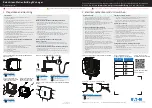
ernmental entities, upon request and to the
extent required, data stored by the manufac‐
turer. For example, this may be the case during
the investigation of a criminal offence.
Governmental entities are themselves, in individ‐
ual cases and within the applicable legal frame‐
work, authorised to read out data from the vehi‐
cle. In the case of an accident, information that
can help with an investigation can, therefore, be
taken from the airbag control unit, for example.
Operational data in the vehicle
This is data regarding the operation of the vehi‐
cle, which have been processed by control units.
This includes the following data, for example:
R
vehicle status information such as the speed,
longitudinal acceleration, lateral accelera‐
tion, number of wheel revolutions or the fas‐
tened seat belts display
R
ambient conditions, such as temperature,
rain sensor or distance sensor
Generally, the use of these data is temporary;
they will not be stored beyond the period of
operation and will only be processed within the
vehicle itself. Control units often contain data
memories for vehicle keys, for example. Their
use permits the temporary or permanent docu‐
mentation of technical information about the
vehicle's operating state, component loads,
maintenance requirements and technical events
or faults.
Depending on the vehicle equipment, the follow‐
ing data are stored:
R
operating status of system components,
such as fill levels, tyre pressure or battery
status
R
malfunctions or faults in important system
components, such as lights or brakes
R
system reactions in special driving situations,
such as airbag deployment or the interven‐
tion of stability control systems
R
information on events leading to vehicle
damage
In certain cases, it may be required to store data
that would have otherwise been used only tem‐
porarily. This may be the case if the vehicle has
detected a malfunction, for example.
If you use services, such as repair services and
maintenance work, stored operational data as
well as the vehicle identification number can be
read out and used. They can be read out by
service network employees, such as workshops
and manufacturers or third parties, such as
breakdown services. The same is true in the
case of warranty claims and quality assurance
measures.
In general, the readout is performed via the
legally prescribed port for the diagnostics con‐
nection in the vehicle. The operational data that
are read out document technical states of the
vehicle or of individual components and assist in
the diagnosis of malfunctions, compliance with
warranty obligations and quality improvement.
To that end, these data, in particular information
about component loads, technical events, mal‐
functions and other faults may be transmitted
along with the vehicle identification number to
the manufacturer. Furthermore, the manufac‐
turer is subject to product liability. For this rea‐
son the manufacturer also uses operational data
from the vehicle, for example, for recalls. These
General notes 33
Summary of Contents for Mercedes-AMG GT4-door coupe
Page 2: ......
Page 3: ......
Page 9: ...Left hand drive vehicles 6 At a glance Cockpit...
Page 12: ......
Page 13: ...Instrument display 10 At a glance Indicator and warning lamps...
Page 15: ...12 At a glance Overhead control panel...
Page 17: ...14 At a glance Door operating unit and seat adjustment...
Page 19: ...16 At a glance Emergencies and breakdowns...
Page 487: ......
Page 488: ......
Page 489: ......
















































